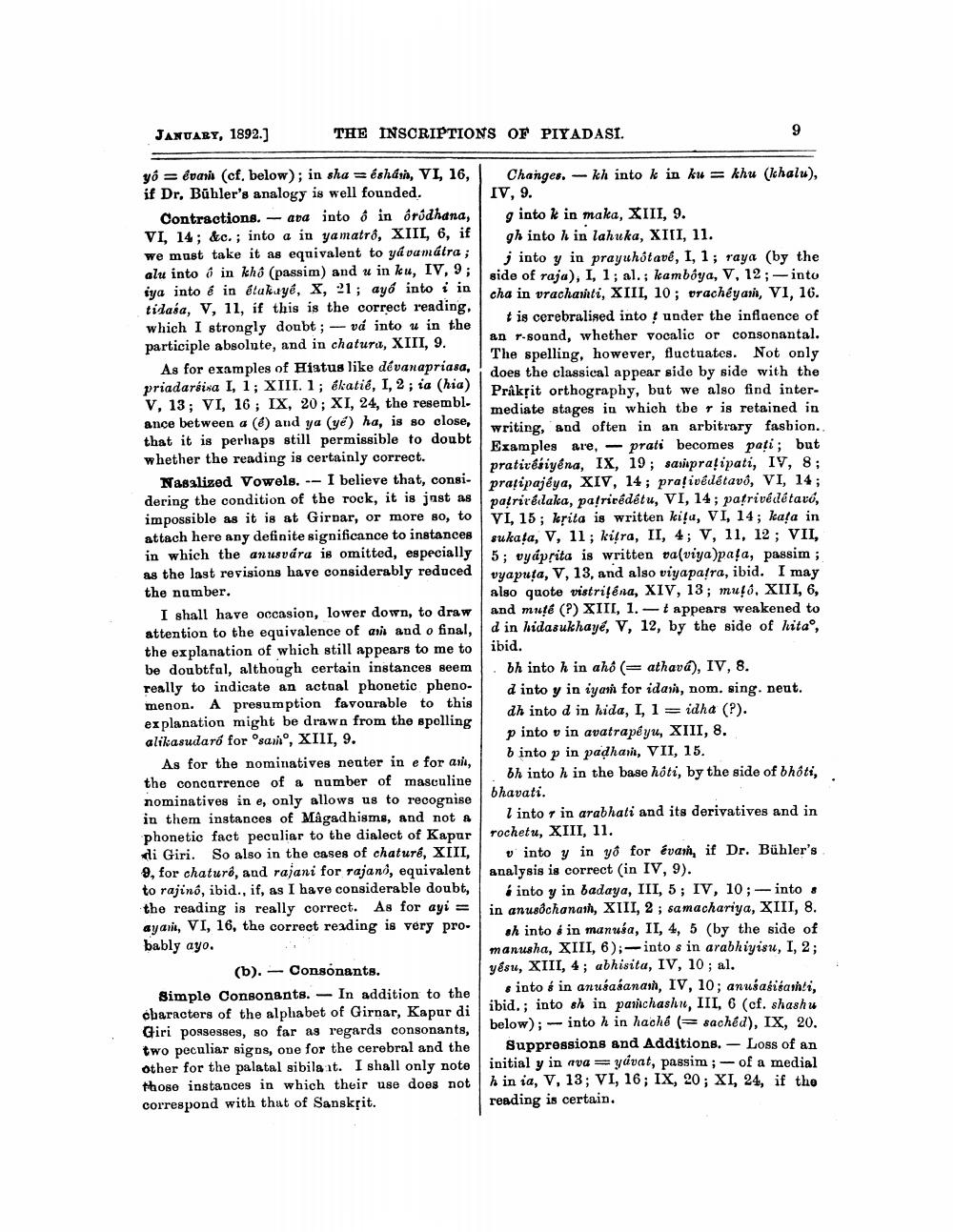________________
JANUARY, 1892.]
THE INSCRIPTIONS OF PIYADASI.
yô = @vani (cf, below); in sha =éshása, VI, 16, Changes. - kh into k in ku = khu (khalu), if Dr. Bühler's analogy is well founded. IV, 9.
Contractions. - ava into 8 in orodhana, ginto k in maka, XIII, 9. VI. 14; &c. ; into a in ya matrô, XIII, 6, if | gh into h in lahuka, XIII, 11. we must take it as equivalent to ya památra ;
į into y in prayuhótavé, 1, 1; raya (by the alu into 6 in khó (passim) and u in ku, IV, 9;
side of raja), I, 1; al.; kamboya, V, 12;- into
side iya into é in élukuyê, x, 21; ayó into i in
cha in vrachati, XIII, 10; orachéya, Vi, 16. tidasa, V, 11, if this is the correct reading,
I which I strongly doubt; - vá into w in the
t is cerebralised into ! under the influence of
an r-sound, whether vocalic or consonantal. participle absolute, and in chaturu, XIII, 9.
The spelling, however, fluctuates. Not only As for examples of Hiatus like dévanapriasa, !
does the classical appear side by side with the priadarsina I, 1; XIII. 1; ékatié, 1, 2; ia (hia)
Praksit orthography, but we also find interV, 13; VI, 16; IX, 20; XI, 24, the resembl.
mediate stages in which tbe r is retained in ance between a (l) and ya (yé) ha, is so close,
writing, and often in an arbitrary fasbion. that it is perhaps still permissible to doubt
Examples are, - prati becomes pați; but whether the reading is certainly correct.
pratirésiyena, IX, 19; sampralipati, IV, 8; Nasalized Vowels. -- I believe that, consi.
prațipajéya, XIV, 14 ; prațivédétavo, VI, 14; dering the condition of the rock, it is just as
palrirédlaka, parrivédétu, VI, 14 ; parrivédétaró, impossible as it is at Girnar, or more so, to VI, 15; krita is written kiļu, VI, 14; kata in attach here any definite significance to instances
sukała, V, 11; kifra, II, 4; V, 11, 12; VII, in which the anusvára is omitted, especially
5; vyáprita is written va(viya)paļa, passim ; as the last revisions have considerably reduced
vyapuța, V, 13, and also viyapatra, ibid. I may the number.
also quote vistriļena, XIV, 13; musXIII, 6, I shall have occasion, lower down, to draw and murs (P) XIII, 1. - t appears weakened to attention to the equivalence of ani and o final, d in hidasukhaye, V, 12, by the side of hita", the explanation of which still appears to me to ibid. be doubtful, although certain instances seem bh into h in aho (= athavd), IV, 8. really to indicate an actual phonetic pheno
d into y in iyah for idari, nom. sing. neut. menon. A presumption favourable to this explanation might be drawn from the spolling
dh into d in hida, 1, 1 = idha (?). alikasudaró for sano, XIII, 9.
p into v in avatrapéyu, XIII, 8. As for the nominatives neater in e for ani,
b into p in padhan, VII, 15. the concurrence of a number of masculine
bh into h in the base hôti, by the side of bhôti, nominatives in e, only allows us to recognise
bhavati. in them instances of Magadhisms, and not a
I l into rin arabhati and its derivatives and in phonetic fact peculiar to the dialect of Kapur rochetu, XIII, 11. di Giri. So also in the cases of chaturé, XIII, v into y in yô for evan, if Dr. Bühler's 9, for chaturó, and rajani for rajano, equivalent analysis is correct (in IV, 9). to rajino, ibid., if, as I have considerable doubt,
i into y in badaya, III, 5; IV, 10; -into the reading is really correct. As for ayi = in anusôchanan, XIII, 2 ; samachariya, XIII, 8. ayant, VI, 16, the correct reading is very pro. sh into é in manusa, II, 4, 5 (by the side of bably ayo.
manusha, XIII, 6); - into e in arabhiyisu, I, 2; (b). - Consonants.
yêsu, XIII, 4; abhisita, IV, 10 ; al. Simple Consonants. - In addition to the
into in anusakanan, IV, 10; anusafisanti, obaracters of the alphabet of Girnar, Kapur di
ibid. ; into sh in panchashu, III, 6 (cf. shashu Giri possesses, so far as regards consonants,
below); - into h in haché (= sachéd), IX, 20. two poculiar signs, one for the cerebral and the Suppressions and Additions. - Loss of an other for the palatal sibila ut. I shall only note
initial y in ava=yávat, passim ;-of a medial those instances in which their use does not h in ia, V, 13; VI, 16; IX, 20; XI, 24, if the correspond with that of Sansksit.
reading is certain.




